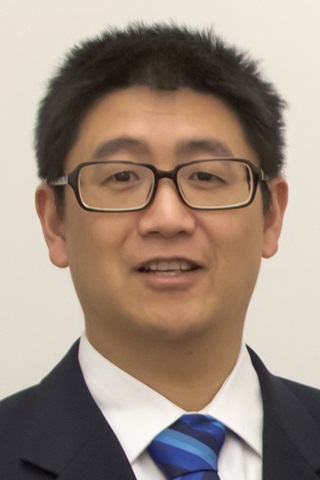Tao Xu
Research Interests
Electrochemical conversion of CO2 to value-added organic molecules, light-matter interaction including spintronics and quantum science, photovoltaics, and solar cells.
Electrochemical Conversion of CO2 to Value-Added Organic Molecules
The conversion of carbon dioxide (CO2) to value-added multi-carbon (C-C bond) organic compounds through electrocatalytic reduction provides a promising route to mitigate greenhouse gas emissions. Our group has developed a series of electrocatalysts using our metal-in-lithium method, enabling the conversion of CO2 into various value-added organic chemicals.
These catalysts include carbon-supported transition and main group metals, varying in size from single atoms to small clusters. These catalysts can electrochemically reduce CO2 into C2 and C3 organic compounds with high single-product selectivity at relatively low potentials.
The reaction mechanism has been extensively studied using operando synchrotron X-ray absorption techniques to reveal the dynamic evolution of the catalytic center. Notably, atomically dispersed catalytic metal atoms aggregate into few-atom clusters under reductive potentials. This evolution, influenced by redox potentials and nanoscale confinement effects of supporting substrates, profoundly impacts reaction pathways toward C-C coupling.
Our work provides atomistic and quantum mechanical-level understanding of the reaction coordination for electrochemical CO2 reduction to a variety of organic compounds. For more details, refer to:
- Nature Energy, 2020, 5, 623–632
- J. Am. Chem. Soc., 2024, 146, 15, 10357–10366
Additional Research Areas
Our group also works on projects involving light-matter interaction, including spintronics and quantum science, as well as photovoltaics and solar cells. See the group page for more details.
Representative Publications
Xiao, X., Latt, K.Z., Gong, J. Kim, T.; Connell, J. G.; Liu, Y.; Fry, H. C.; Pearson, J. E.; Wostoupal, O. S.; Li, M.; Soldan, C.; Yang, Z.; Schaller, R. D.; Diroll, B. T.; Hla S. W.; Xu, T. Light-induced Kondo-like exciton-spin interaction in neodymium(II) doped hybrid perovskite. Nature Communication, 2024, 15, 6084.
Xu, H.; Wang, J.; He, H.; Hwang, I.; Liu, Y.; Sun, C.; Zhang, H.; Li, T.; Muntean, J. V. Muntean, Xu, T.; Liu, D.-J. Modulating CO2 electrocatalytic conversion to organics pathway by the catalytic site dimension, J. Am. Chem. Soc. 2024, 146, 10357–10366
Wostoupal, W. S.; Meyer, J.; Griffith, J.; Rasamani, K. D.; Frank, C. E.; Shevchenko, E.; Lin, X.-M. Lin; Arigong, B. Xu, T.; and Li, J. Advanced VO2/Polymer Nanocomposite Smart Window Films Using VO2 Nanoparticles from High-Throughput Flow Synthesis, ACS Appl. Opt. Mater. 2024
Xu, J.; Patel, P.; Liu, D.-J.; Xu, T.; Liu, C. Understanding the dynamic evolution of atomically dispersed Cu catalyst for CO2 electrochemical conversion using integrated XANES analysis and mechanistic studies, Journal of Catalysis, 2023, 425, 296-305.
Li, M. Park, S. Y.; Wang, J.; Zheng, D.; Wostoupal, O. S.; Xiao, X.; Yang, Z.; Li, X.; Diroll, B. T.; Marks, T. J.; Zhu, K.; Xu, T. Nickel-Doped Graphite and Fusible Alloy Bilayer Back Electrode for Vacuum-Free Perovskite Solar Cells. ACS Energy Letters, 2023, 8, 2940-2945.
Tong, J.; Li, X.; Wang, J.; He, H.; Xu, T.; Zhu, K. Bioinspired stability enhancement in deuterium-substituted organic-inorganic hybrid perovskite solar cells, Proc. Natl. Acad. Sci. U.S.A. Nexus, 2023, 2(5), 160.
Dahunsi, O. J.; Li, B.; Gao, S.; Lu, K.; Xia, F.; Xu, T.; Cheng, Y. One-Step Synthesis of Na–Sn Alloy with Internal 3D Na15Sn4 Support for Fast and Stable Na Metal Batteries, ACS Appl. Energy Mater. 2022, 5, 20–26.
Li, X.; Zhang, F.; Wang, J.; Tong, J.; Xu, T.; Zhu, K.; On-device lead-absorbing tapes for sustainable perovskite solar cells, Nature Sustainability, 2021, 4, 1038–1041.
Contact

Tao Xu
Professor
La Tourette Hall 412
815-753-6357
txu@niu.edu
Tao Xu Group website
Curriculum Vitae
Educational Background
- Postdoctoral Research Associate, Argonne National Laboratory, 2004–2006
- Research Associate, Texas A&M University, 2003–2004
- Ph.D., University of Alabama, 2003
- B.S., East China University of Science and Technology, 1995